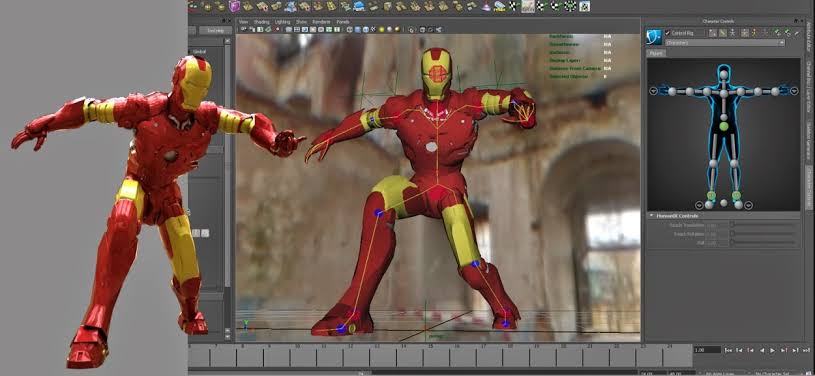
Are you passionate about bringing characters and scenes to life through animation? If so, a career as a 3D animator might be the perfect fit for you. In this blog post, we will explore the role of a 3D animator, including their job responsibilities and required skills. We will also discuss the importance of education and qualifications, as well as the average salary range for 3D animators. Additionally, we will delve into the factors influencing 3D animator salaries, job market trends, and opportunities for career growth in the field of 3D animation. Whether you’re just starting your journey as a 3D animator or are looking to advance in your career, this post will provide valuable insight into the variations in 3D animator salaries based on industry, the top-paying industries for 3D animators, and the geographical impact on 3D animator salaries. Lastly, we will explore additional income opportunities for 3D animators, helping you to make the most of your career in this dynamic and exciting field.
Contents
- 1 What Is A 3D Animator?
- 2 Job Responsibilities Of A 3D Animator
- 3 Skills Required For 3D Animators
- 4 Importance Of Education And Qualifications
- 5 Average Salary Range For 3D Animators
- 6 Factors Influencing 3D Animator Salaries
- 7 Job Market Trends For 3D Animators
- 8 Opportunities For Career Growth In 3D Animation
- 9 Variations In 3D Animator Salaries Based On Industry
- 10 Top-Paying Industries For 3D Animators
- 11 Geographical Impact On 3D Animator Salaries
- 12 Additional Income Opportunities For 3D Animators
- 13 Frequently Asked Questions
What Is A 3D Animator?
A 3D animator is a skilled professional who uses computer software to create moving images. They specialize in creating lifelike animations that are used in various industries such as film, television, advertising, and video games. 3D animation is a complex process that involves designing and animating characters, objects, and environments in a three-dimensional space.
One of the key responsibilities of a 3D animator is to bring characters and objects to life. They use specialized software and tools to create realistic movements, gestures, and facial expressions. By manipulating the position, rotation, and scale of various elements in a 3D scene, animators are able to create the illusion of movement. They also work closely with other members of the production team, such as modelers and riggers, to ensure that the animation is consistent with the overall vision of the project.
Strong interpersonal and problem-solving skills are essential for 3D animators. They often collaborate with directors, art directors, and other team members to understand the requirements of a project and deliver animations that meet the desired creative and technical standards. Additionally, animators need to be able to troubleshoot any issues that arise during the animation process, such as rigging problems or rendering errors. Attention to detail is crucial in the field of 3D animation, as even the smallest imperfections can be noticeable in the final product.
Job Responsibilities Of A 3D Animator
As a 3D animator, your role is to bring life to characters, objects, and environments in animations, films, video games, and other digital media. You are responsible for creating realistic and captivating visuals that engage and entertain audiences. The job of a 3D animator involves a combination of technical skills and artistic creativity.
One of the primary responsibilities of a 3D animator is to develop and refine animations through the use of specialized software. This includes creating and manipulating 3D models, rigging characters, applying textures and materials, and animating objects within a virtual environment. Attention to detail is crucial in order to ensure smooth and seamless movement, as well as realistic physics and lighting effects.
Another important aspect of the role is collaborating with other members of the production team, such as directors, scriptwriters, and designers. As a 3D animator, you need to understand the overall vision of the project and be able to translate it into compelling visuals. Effective communication skills are essential for discussing ideas, sharing progress, giving and receiving feedback, and making necessary adjustments to meet the desired artistic direction.
Additionally, 3D animators are often responsible for problem-solving and troubleshooting technical issues that arise during the animation process. This may involve experimenting with different techniques, exploring new tools, or finding creative solutions to overcome limitations. Adaptability and the ability to work under pressure are key qualities for success in this aspect of the job.
In conclusion, the job responsibilities of a 3D animator encompass a wide range of tasks, from creating and refining animations to collaborating with other team members and problem-solving. It requires a combination of technical skills, artistic creativity, attention to detail, and effective communication. Despite the challenges, being a 3D animator can be a rewarding career for those passionate about bringing imagination to life on the screen.
Skills Required For 3D Animators
When it comes to being a successful 3D animator, there are certain skills that are essential to possess. These skills not only help animators excel in their field but also set them apart from others. Let’s take a look at some of the key skills required for 3D animators.
1. Creativity: Creativity is at the core of the animation field. 3D animators need to have a keen artistic eye and the ability to think outside the box. They should be able to come up with unique and visually appealing designs and concepts.
2. Technical Knowledge: In addition to creativity, technical knowledge is crucial for 3D animators. They must be well-versed in various computer software programs used for animation, such as Autodesk Maya or 3ds Max. Having a strong grasp of modeling, rigging, and texturing techniques is also important.
3. Attention to Detail: Animation requires a high level of precision and attention to detail. 3D animators need to pay close attention to the movements, textures, and lighting to ensure a realistic and engaging final product. They should strive for perfection in every aspect of their work.
4. Communication and Collaboration: 3D animators often work as part of a team, collaborating with other animators, artists, and designers. Therefore, strong communication skills are essential to effectively convey ideas and understand the vision of the project. Being able to listen, give feedback, and work well with others is crucial in this field.
5. Time Management: Animation projects often come with strict deadlines, so time management is a vital skill for 3D animators. They need to be able to prioritize tasks, work efficiently, and meet deadlines without compromising the quality of their work.
6. Problem-Solving Abilities: In the world of animation, unexpected challenges often arise. 3D animators should have strong problem-solving abilities to overcome technical issues or creative roadblocks that may occur during the animation process. They need to be innovative and adaptable in finding solutions.
In conclusion, mastering these essential skills can greatly enhance a 3D animator’s career prospects and help them stand out in this competitive industry. Whether it’s being creative, technically proficient, attention to detail, or having effective communication and time management skills, each of these abilities plays a vital role in the success of a 3D animator.
Importance Of Education And Qualifications
Education and qualifications play a vital role in the career of a 3D animator. In the fast-paced world of animation, staying ahead of the curve requires a strong foundation of knowledge and skills. Whether you’re just starting out or looking to advance your career, investing in education and qualifications can open doors to new opportunities and higher earning potential.
Having a formal education in animation or a related field provides a solid framework for understanding the principles and techniques of 3D animation. A degree program typically covers topics such as character design, storyboarding, modeling, texturing, rigging, and animation. By studying these subjects, aspiring animators can develop the necessary technical and artistic skills to bring their creations to life.
Furthermore, pursuing a degree allows animators to gain exposure to industry-standard software and tools. These programs, such as Autodesk Maya, Adobe After Effects, and Cinema 4D, are widely used in the animation industry. Becoming proficient in these tools can give animators a competitive edge and make them more attractive to potential employers.
- Specialization: Education and qualifications also provide an opportunity for animators to specialize in a specific area of 3D animation. This can include character animation, visual effects, motion graphics, or architectural visualization. By focusing their skills on a particular niche, animators can position themselves as experts in their field and increase their earning potential.
- Networking: Another benefit of education and qualifications is the chance to network with industry professionals and like-minded individuals. Attending college or participating in workshops and conferences allows animators to build relationships, gain mentors, and explore job opportunities. Networking can be a valuable asset in the competitive animation industry, as it can lead to referrals and collaborations.
- Professional Validation: Lastly, education and qualifications provide a sense of professional validation. Obtaining a degree or certification demonstrates a commitment to the field and shows potential employers that you have the necessary knowledge and skills to succeed. This can give animators a leg up during the job application process and contribute to long-term career growth.
In conclusion, the importance of education and qualifications for 3D animators cannot be overstated. Investing in a formal education provides a strong foundation of knowledge, exposure to industry-standard software, and the opportunity to specialize in a specific area. Additionally, education allows animators to network with professionals and gain a sense of professional validation. By continuously learning and growing, animators can unlock new opportunities, advance their careers, and maximize their earning potential in the dynamic field of 3D animation.
Average Salary Range For 3D Animators
When considering a career in 3D animation, one important aspect to consider is the average salary range for 3D animators. As with any profession, salary can vary based on various factors such as experience, skills, education, and industry. Understanding the average salary range can help aspiring 3D animators make informed decisions about their career path.
According to industry reports and data, the average salary range for 3D animators can vary significantly. Entry-level animators with less than one year of experience can expect to earn an average annual salary ranging from $35,000 to $50,000. As animators gain experience and expertise, their average annual salary can increase to anywhere between $50,000 and $70,000. Highly skilled and senior 3D animators with extensive experience can earn salaries exceeding $70,000, reaching up to $100,000 or more.
It is important to note that these salary figures are general estimates and can be influenced by various factors. One such factor is the specific industry in which the 3D animator works. For example, animators working in the film and television industry may have higher earning potential compared to those in the gaming or advertising industry. This can be due to the larger budgets typically allocated to film and television productions.
| Industry | Average Salary Range |
|---|---|
| Film and Television | $60,000 – $100,000+ |
| Gaming | $50,000 – $80,000 |
| Advertising | $40,000 – $70,000 |
Another factor that can influence a 3D animator’s salary is geographical location. Salaries can vary based on the cost of living in different regions. For instance, animators working in major cities with a high cost of living, such as New York or Los Angeles, may earn higher salaries compared to animators in smaller towns or rural areas.
In conclusion, the average salary range for 3D animators can vary depending on factors such as experience, skills, education, industry, and geographical location. It is essential for aspiring animators to research and consider these factors when planning their career path. While the potential for higher salaries exists with increased experience and expertise, it is important to also keep in mind the influence of industry and location on earning potential. Overall, 3D animation can offer a rewarding and creatively fulfilling career, with the potential for attractive salaries.
Factors Influencing 3D Animator Salaries
When considering a career in 3D animation, it is essential to understand the various factors that can influence an animator’s salary. While talent and experience are significant contributors, several other elements play a crucial role in determining an animator’s earning potential. These factors include industry, geographical location, education and qualifications, job responsibilities, and opportunities for career growth.
Industry: The industry in which a 3D animator works can significantly impact their salary. Animators employed in the film and television industry tend to earn higher salaries compared to those working in gaming or advertising. This is because the demand for skilled animators is higher in industries that produce feature films and TV shows, resulting in increased competition and better pay.
Geographical Location: The location of an animator’s job also influences their earning potential. Salaries can vary depending on the cost of living in a particular area. For instance, animators working in major cities like Los Angeles or New York may earn higher salaries compared to those in smaller towns or rural areas. Furthermore, certain regions or countries may have a higher demand for animators, offering greater job opportunities and better compensation.
Education and Qualifications: The level of education and qualifications an animator possesses can have a direct impact on their salary. Completing a degree in animation or a related field from a reputable institution can provide individuals with a competitive edge in the job market. Additionally, having certifications or specialized training in specific animation software or techniques can also increase an animator’s earning potential.
Job Responsibilities: The scope of an animator’s job responsibilities can influence their salary. Senior animators or those in leadership positions may be responsible for managing a team or overseeing complex projects, resulting in higher pay. On the other hand, entry-level animators or those with less experience may have more limited responsibilities, which can impact their earning potential.
Opportunities for Career Growth: The availability of opportunities for career growth within the animation industry can affect an animator’s salary. By continuously developing their skills, gaining experience, and taking on challenging projects, animators can advance in their careers and potentially earn higher salaries. Additionally, networking and building connections within the industry can open doors to new opportunities and higher-paying positions.
In conclusion, while talent and experience are important factors in determining a 3D animator’s salary, several other elements come into play. The industry in which an animator works, their geographical location, education and qualifications, job responsibilities, and opportunities for career growth all contribute to an animator’s earning potential. By understanding and considering these factors, aspiring animators can make informed decisions and take steps to maximize their salaries in this dynamic and exciting field.
Job Market Trends For 3D Animators
As technology continues to advance and the demand for visual effects in various industries increases, the job market for 3D animators is experiencing a positive trend. With the rise of streaming platforms, video games, and virtual reality experiences, there is a growing need for skilled professionals who can bring lifelike characters and immersive environments to life.
One of the key factors driving this trend is the ever-expanding entertainment industry. Movies, TV shows, and video games are incorporating more and more visual effects, requiring the expertise of 3D animators to create realistic and visually stunning content. Additionally, businesses across various sectors, such as advertising, marketing, and architecture, are recognizing the value of incorporating 3D animation into their promotional materials and presentations.
| Factors | Influence |
|---|---|
| Technological Advancements | With the emergence of new technology such as virtual reality and augmented reality, the demand for 3D animators with knowledge and experience in these areas is increasing. |
| Globalization | The globalization of entertainment and media industries has led to a higher demand for 3D animators in various regions around the world. |
| Outsourcing | Some companies outsource their animation projects to countries with lower labor costs, which can affect job opportunities and salaries for 3D animators in certain regions. |
Another important trend in the job market for 3D animators is the growing emphasis on specialization. As the field continues to expand, professionals who specialize in specific areas, such as character animation, visual effects, or architectural visualization, are in high demand. Employers are seeking individuals with expertise in these domains to create high-quality, specialized content.
The freelance market for 3D animators is also on the rise. Many companies are opting to hire freelancers for short-term projects, allowing them to tap into a global pool of talent without the need for long-term employment contracts. However, competition among freelancers can be intense, as individuals must constantly showcase their skills and build a strong portfolio to stand out in the market.
Overall, the job market for 3D animators is showing promising growth and offers a range of opportunities for those with the required skills and qualifications. Staying up-to-date with the latest technological advancements and continuously honing specialized skills can greatly enhance one’s chances of success in this dynamic and exciting field.
Opportunities For Career Growth In 3D Animation
Opportunities for Career Growth in 3D Animation
For individuals passionate about art and technology, a career in 3D animation can offer numerous opportunities for growth and advancement. In today’s technologically advanced world, the demand for skilled 3D animators continues to rise, opening up doors to exciting career prospects in various industries.
One of the most appealing aspects of pursuing a career in 3D animation is the potential for constant learning and skill development. As technology evolves, new software and tools are constantly being introduced, providing animators with opportunities to expand their knowledge and stay up-to-date with the latest industry trends.
In addition to skill development, career growth in 3D animation can involve moving up the ladder within a company or taking on new projects and challenges. Animators who exhibit exceptional talent and dedication may have the chance to become lead animators or supervisors, overseeing a team of artists and ensuring the successful completion of projects. This not only provides higher salaries but also adds a sense of accomplishment and professional fulfillment.
Variations In 3D Animator Salaries Based On Industry
When it comes to pursuing a career in 3D animation, it’s important to consider the potential salary opportunities that exist within different industries. The salary of a 3D animator can vary significantly based on the industry in which they work. In this blog post, we will explore the variations in 3D animator salaries based on industry.
One industry that offers high-paying opportunities for 3D animators is the film and television industry. 3D animators in this industry typically work on creating visual effects and computer-generated imagery (CGI) for movies, TV shows, and commercials. Due to the high demand for high-quality animation in these fields, 3D animators can command higher salaries. The average salary range for 3D animators in the film and television industry can range from $70,000 to $120,000 per year.
Another industry that offers favorable salary prospects for 3D animators is the video game industry. As the gaming industry continues to grow and evolve, the demand for skilled animators to create realistic and immersive gaming experiences is also increasing. 3D animators working in the gaming industry can expect to earn competitive salaries, especially in large gaming studios. The average salary range for 3D animators in the video game industry is between $65,000 and $100,000 per year.
On the other hand, 3D animators working in the advertising and marketing industry may experience lower average salaries compared to those working in film, television, or gaming. In this industry, 3D animators are responsible for creating animations and visual effects for various advertising campaigns, product promotions, and marketing materials. While the salaries may be lower, the demand for 3D animators in this industry remains constant, providing steady employment opportunities. 3D animators in the advertising and marketing industry can expect an average salary range of $50,000 to $80,000 per year.
| Industry | Average Salary Range |
|---|---|
| Film and Television | $70,000 – $120,000 |
| Video Game | $65,000 – $100,000 |
| Advertising and Marketing | $50,000 – $80,000 |
It’s important to note that these salary ranges are approximate and can vary based on factors such as experience, skill level, location, and the size of the company. Additionally, freelance 3D animators may have different earning potentials compared to those who are employed full-time.
In conclusion, the salary of a 3D animator can vary greatly depending on the industry in which they work. The film and television industry and the video game industry generally offer higher salary prospects, while the advertising and marketing industry may have lower average salaries. Ultimately, it’s important for aspiring 3D animators to consider their interests, skills, and long-term goals when choosing the industry in which they want to work.
Top-Paying Industries For 3D Animators
When it comes to pursuing a career in 3D animation, one important factor to consider is the potential salary. While the salary for 3D animators can vary greatly depending on various factors, such as experience, skills, and location, the industry in which they work can also play a significant role in determining their income. In this blog post, we will explore some of the top-paying industries for 3D animators, shedding light on the opportunities available and the potential income that can be earned.
1. Film and Television Industry:
The film and television industry is one of the top-paying industries for 3D animators. This is because major production houses and studios often hire skilled animators to bring their characters and stories to life. These animators work on animated movies, television shows, and commercials, earning a competitive salary for their creative work. Additionally, with the rise of streaming platforms and the increasing demand for animated content, the opportunities for 3D animators in this industry continue to grow.
2. Video Game Development:
Another lucrative industry for 3D animators is video game development. As the gaming industry becomes more advanced and immersive, the need for skilled animators to create realistic characters, environments, and animations is in high demand. 3D animators in this industry work closely with game designers and developers to bring their vision to life. Whether it’s creating lifelike movements for characters or designing visually stunning game worlds, animators in the gaming industry can earn a handsome salary for their contributions.
3. Advertising and Marketing:
The advertising and marketing industry is also a top-paying sector for 3D animators. In this sector, animators use their skills to create engaging and visually appealing advertisements, promotional videos, and digital content. Whether it’s a television commercial, an animated banner ad, or a social media campaign, animators in this industry have the opportunity to showcase their creativity and technical expertise. The demand for high-quality visuals in advertising and marketing campaigns makes it a promising field for 3D animators looking to earn a competitive salary.
| Industry | Salary Range (per year) |
|---|---|
| Film and Television | $50,000 – $100,000+ |
| Video Game Development | $60,000 – $90,000+ |
| Advertising and Marketing | $50,000 – $90,000+ |
While these industries are known for offering competitive salaries to 3D animators, it’s important to note that individual salaries may vary based on factors such as experience, location, and the size of the company. Additionally, freelancing or working as a self-employed animator can also provide opportunities for higher income, as animators can set their own rates and take on projects from different industries.
In conclusion, for 3D animators seeking high-paying opportunities, the film and television industry, video game development, and advertising and marketing sector offer promising prospects. By honing their skills, staying updated with the latest industry trends, and building a strong portfolio, animators can position themselves for success in these top-paying industries.
Geographical Impact On 3D Animator Salaries
When it comes to considering a career as a 3D animator, it is important to take into account the various factors that can impact your potential salary. One such factor is the geographical location in which you work. Just like any other profession, the demand and cost of living can vary greatly from one place to another, leading to significant differences in earning potential for 3D animators.
Let’s first take a look at the average salary range for 3D animators in different locations. In major cities with a thriving animation industry, such as Los Angeles, New York City, and Vancouver, 3D animators tend to earn higher salaries due to the higher cost of living and greater demand for their skills. On the other hand, in areas with less demand for animation talent or a lower cost of living, such as smaller towns or rural areas, the salaries may be comparatively lower.
Furthermore, the availability of job opportunities can also greatly impact the salaries of 3D animators in different regions. In locations with a vibrant animation industry, there are likely to be more job openings and a higher demand for skilled animators. This competition for talent often drives up salaries and overall compensation packages. Conversely, in areas where there are fewer animation studios or a limited number of projects, the job market may be more competitive, leading to lower salaries.
- Cost of living
- Job opportunities
- Competition for talent
| Location | Average Salary Range |
|---|---|
| Los Angeles, California | $65,000 – $90,000 |
| New York City, New York | $60,000 – $85,000 |
| Vancouver, Canada | $55,000 – $75,000 |
| Austin, Texas | $50,000 – $70,000 |
As seen in the table above, the geographical impact on 3D animator salaries can be significant. However, it is important to note that these ranges are approximate and can vary depending on factors such as experience, skills, and the specific studio or industry in which you work.
In conclusion, when considering a career as a 3D animator, it is essential to take into account the geographical location and its impact on potential salaries. The cost of living, job opportunities, and competition for talent can all play a role in determining the earning potential in different regions. It is advisable to research and compare the salaries and job markets in various locations to make an informed decision about your career path.
Additional Income Opportunities For 3D Animators
The field of 3D animation offers a variety of opportunities for skilled professionals to earn a lucrative income. In addition to the typical salary that 3D animators receive, there are several additional income opportunities that can further boost their earnings. These opportunities can be in the form of freelance projects, royalties, licensing deals, and teaching positions, among others.
Freelancing is a popular choice for many 3D animators who want to earn additional income. As a freelancer, animators can take on projects from various clients and work on their own terms. This allows them to have flexibility in choosing the projects that align with their skills and interests. Freelancing can be particularly lucrative for experienced animators who have established a strong reputation in the industry.
In addition to freelancing, another potential source of additional income for 3D animators is through royalties and licensing deals. When animators create original characters or content that gains popularity, they can earn royalties whenever their work is used or licensed by others. This can include merchandise, video games, films, and more. Royalties and licensing deals can provide a steady stream of income and can be especially beneficial for animators with a knack for creating memorable characters or compelling stories.
| Opportunity | Description |
|---|---|
| Teaching | 3D animators can also explore opportunities in teaching. They can work as instructors in colleges, universities, or specialized animation schools, sharing their knowledge and expertise with aspiring animators. Teaching can be a fulfilling and stable source of income, and it allows animators to stay connected to the latest trends and techniques in the field. |
| Online Marketplaces | Various online marketplaces provide platforms for animators to sell their 3D models, assets, or animations. These marketplaces connect animators with buyers and offer a convenient way to monetize their skills. Animators can create and sell high-quality assets, such as character models, environmental designs, or motion capture data, generating income even when they are not actively working on a project. |
It’s worth noting that additional income sources may vary depending on an animator’s specialization and the industry they work in. For example, animators who specialize in architectural visualization may have opportunities to create virtual tours or renderings for real estate companies, adding another income stream to their portfolio. Similarly, animators working in the advertising industry may have the chance to collaborate with brands on commercial projects, which can provide additional compensation.
In conclusion, 3D animators have various opportunities to earn additional income alongside their regular salary. Whether through freelancing, royalties, teaching, or participating in online marketplaces, animators can leverage their skills and creativity to create multiple income streams. Exploring these opportunities not only boosts their earnings but also allows them to expand their professional network and gain diverse experiences in the field of 3D animation.
Frequently Asked Questions
What is a 3D animator?
A 3D animator is a professional who creates moving images and visual effects using computer-generated 3D models and animations.
What are the job responsibilities of a 3D animator?
The job responsibilities of a 3D animator include designing and creating 3D models, animating characters and objects, collaborating with the creative team, and ensuring the quality of the final product.
What skills are required for 3D animators?
Skills required for 3D animators include proficiency in animation software, knowledge of modeling and rigging techniques, creativity, attention to detail, and the ability to work well in a team.
Why is education and qualifications important for 3D animators?
Education and qualifications are important for 3D animators as they provide a strong foundation in animation principles and techniques, enhance technical skills, and improve job prospects in a competitive industry.
What is the average salary range for 3D animators?
The average salary range for 3D animators varies depending on factors such as experience, skills, location, and industry, but it typically falls between $50,000 to $80,000 per year.
What factors influence 3D animator salaries?
Factors influencing 3D animator salaries include experience, specialization, location, industry demand, project size and complexity, and the reputation of the animator or studio.
What are the job market trends for 3D animators?
The job market for 3D animators is growing steadily with increasing demand in industries such as film, television, video games, advertising, and virtual reality. The demand for animators with skills in augmented reality and virtual reality is also on the rise.




